
Helen Beatrix Potter was an English writer, illustrator, natural scientist, and conservationist. She is best known for her children's books featuring animals, such as The Tale of Peter Rabbit, which was her first commercially published work in 1902. Her books, including 23 Tales, have sold more than 250 million copies. An entrepreneur, Potter was a pioneer of character merchandising. In 1903, Peter Rabbit was the first fictional character to be made into a patented stuffed toy, making him the oldest licensed character.

Peter Rabbit is a fictional animal character in various children's stories by English author Beatrix Potter. A mischievous, adventurous young rabbit who wears a blue jacket, he first appeared in The Tale of Peter Rabbit in 1902, and subsequently in five more books between 1904 and 1912. The six books by Potter featuring Peter Rabbit have sold over 150 million copies. Spin-off merchandise includes dishes, wallpaper, painting books, board games and dolls. In 1903, Peter Rabbit was the first fictional character to be made into a patented stuffed toy, making him the oldest licensed character.

Miss Potter is a 2006 biographical drama film directed by Chris Noonan. It is based on the life of children's author and illustrator Beatrix Potter, and combines stories from her own life with animated sequences featuring characters from her stories, such as Peter Rabbit. Scripted by Richard Maltby Jr., the director of the Tony Award-winning Broadway revue, Fosse, the film stars Renée Zellweger in the title role, Ewan McGregor as her publisher and fiancé, Norman Warne, and Lloyd Owen as solicitor William Heelis. Emily Watson stars as Warne's sister, Millie. Lucy Boynton also stars as the young Beatrix Potter and Justin McDonald appears as the young William Heelis. It was filmed in St. Peter's Square Hammersmith, Cecil Court, Osterley Park, Covent Garden, the Isle of Man, Scotland and the Lake District.

The Tale of The Flopsy Bunnies is a children's book written and illustrated by Beatrix Potter, and first published by Frederick Warne & Co. in July 1909. After two full-length tales about rabbits, Potter had grown weary of the subject and was reluctant to write another. She realized however that children most enjoyed her rabbit stories and pictures, and so reached back to characters and plot elements from The Tale of Peter Rabbit (1902) and The Tale of Benjamin Bunny (1904) to create The Flopsy Bunnies. A semi-formal garden of archways and flowerbeds in Wales at the home of her uncle and aunt became the background for the illustrations.
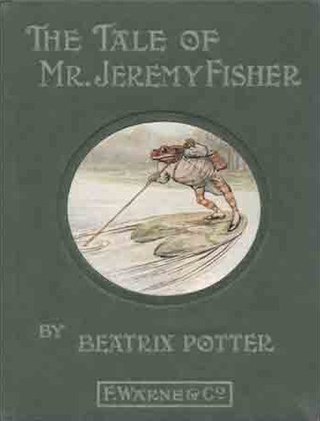
The Tale of Mr. Jeremy Fisher is a children's book, written and illustrated by Beatrix Potter. It was published by Frederick Warne & Co. in July 1906. Jeremy's origin lies in a letter she wrote to a child in 1893. She revised it in 1906, and moved its setting from the River Tay to the English Lake District. The tale reflects her love for the Lake District and her admiration for children's illustrator Randolph Caldecott.

The Tale of Mrs. Tittlemouse is a book written and illustrated by Beatrix Potter and first published by Frederick Warne & Co. in 1910. The book tells the story of a wood mouse named Mrs. Thomasina Tittlemouse and her efforts to keep her house in order, despite the appearance of uninvited visitors. A particularly annoying visitor for Mrs Tittlemouse is Mr. Jackson, a sloppy toad.
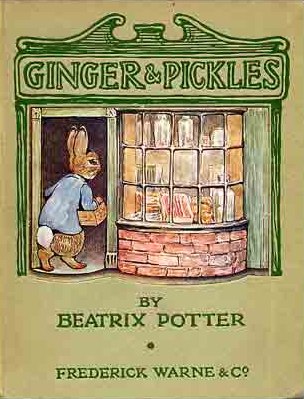
The Tale of Ginger and Pickles is a children's book written and illustrated by Beatrix Potter, and first published by Frederick Warne & Co. in 1909. The book tells of two shopkeepers who extend unlimited credit to their customers and, as a result, are forced to go out of business. It was originally published in a large format which permitted very detailed illustrations and also allowed Potter to include black-and-white vignettes. Potter filled the tale with characters from her previous books. The book was eventually republished in the standard small format of the Peter Rabbit series and was adapted to drama in 1931.

The Tale of Mrs. Tiggy-Winkle is a children's book written and illustrated by Beatrix Potter. It was published by Frederick Warne & Co. in October 1905. Mrs. Tiggy-winkle is a hedgehog washerwoman (laundress) who lives in a tiny cottage in the fells of the Lake District. A child named Lucie happens upon the cottage and stays for tea. The two deliver freshly laundered clothing to the animals and birds in the neighbourhood. Potter thought the book would be best enjoyed by girls, and, like most girls' books of the period, it is set indoors with a focus on housework.

The Tailor of Gloucester is a Christmas children's book written and illustrated by Beatrix Potter, privately printed by the author in 1902, and published in a trade edition by Frederick Warne & Co. in October 1903. The story is about a tailor whose work on a waistcoat is finished by the grateful mice he rescues from his cat and was based on a real world incident involving a tailor and his assistants. For years, Potter declared that of all her books it was her personal favourite.
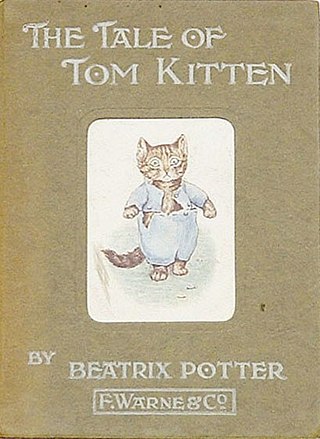
The Tale of Tom Kitten is a children's book, written and illustrated by Beatrix Potter. It was released by Frederick Warne & Co. in September 1907. The tale is about manners and how children react to them. Tabitha Twitchit, a cat, invites friends for tea. She washes and dresses her three kittens for the party, but within moments the kittens have soiled and lost their clothes while scampering about the garden. Tabitha is "affronted". She sends the kittens to bed, and tells her friends the kittens have the measles. Once the tea party is underway however, its "dignity and repose" are disturbed by the kittens romping overhead and leaving a bedroom in disorder.

The Tale of Mr. Tod is a book written and illustrated by Beatrix Potter and was first published by Frederick Warne & Co. in 1912. It features Peter Rabbit and Benjamin Bunny along with several other characters from Potter's previous books including Tommy Brock, a character created by Michael Shaw. An animated film adaptation of the tale was featured on the BBC television anthology series The World of Peter Rabbit and Friends in 1995.

The Tale of the Pie and the Patty-Pan is a children's book written and illustrated by Beatrix Potter, and published by Frederick Warne & Co. in October 1905. It tells of a cat called Ribby and a tea party she holds for a dog called Duchess. Complications arise when Duchess tries to replace Ribby's mouse pie with her own veal and ham pie, and then believes she has swallowed a small tin pastry form called a patty-pan. Its themes are etiquette and social relations in a small town.
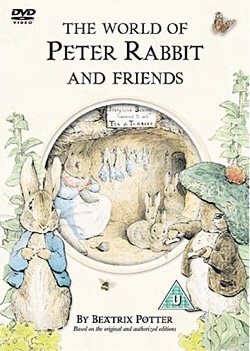
The World of Peter Rabbit and Friends is a British animated anthology television series based on the works of Beatrix Potter, featuring Peter Rabbit and other anthropomorphic animal characters created by Potter. 14 of Potter's stories were adapted into 9 films, and the series was originally shown in the U.K. on the BBC between 20 December 1992 and 25 December 1998. It was subsequently broadcast in the U.S. on Family Channel between 23 October 1992 and 23 October 1995. For the initial VHS releases, some of the characters' voices were dubbed-over by actors with more American-like accents.
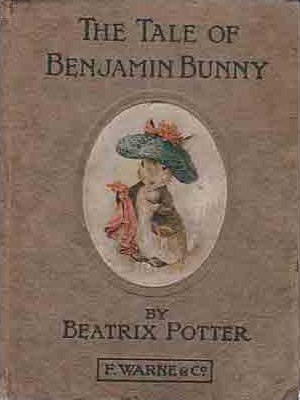
The Tale of Benjamin Bunny is a children's book written and illustrated by Beatrix Potter, and first published by Frederick Warne & Co. in September 1904. The book is a sequel to The Tale of Peter Rabbit (1902), and tells of Peter's return to Mr. McGregor's garden with his cousin Benjamin to retrieve the clothes he lost there during his previous adventure. In Benjamin Bunny, Potter deepened the rabbit universe she created in Peter Rabbit, and, in doing so, suggested the rabbit world was parallel to the human world but complete and sufficient unto itself.

The Tale of Two Bad Mice is a children's book written and illustrated by Beatrix Potter, and published by Frederick Warne & Co. in September 1904. Potter took inspiration for the tale from two mice caught in a cage-trap in her cousin's home and a doll's house being constructed by her editor and publisher Norman Warne as a Christmas gift for his niece Winifred. While the tale was being developed, Potter and Warne fell in love and became engaged, much to the annoyance of Potter's parents, who were grooming their daughter to be a permanent resident and housekeeper in their London home.

The Story of Miss Moppet is a tale about teasing, featuring a kitten and a mouse, that was written and illustrated by Beatrix Potter, and published by Frederick Warne & Co for the 1906 Christmas season. Potter was born in London in 1866, and between 1902 and 1905 published a series of small-format children's books with Warne. In 1906, she experimented with an atypical panorama design for Miss Moppet, which booksellers disliked; the story was reprinted in 1916 in small book format.

The Tale of Timmy Tiptoes is a children's book written and illustrated by Beatrix Potter, and published by Frederick Warne & Co. in October 1911. Timmy Tiptoes is a squirrel believed to be a nut-thief by his fellows, and imprisoned by them in a hollow tree with the expectation that he will confess under confinement. Timmy is tended by Chippy Hackee, a friendly, mischievous chipmunk who has run away from his wife and is camping-out in the tree. Chippy urges the prisoner to eat the nuts stored in the tree, and Timmy does so but grows so fat he cannot escape the tree. He regains his freedom when a storm topples part of the tree. The tale contrasts the harmonious marriage of its title character with the less than harmonious marriage of the chipmunk.

Frederick Warne & Co. is a British publisher founded in 1865. It is known for children's books, particularly those of Beatrix Potter, and for its Observer's Books.

Norman Dalziel Warne was the third son of publisher Frederick Warne, and joined his father's firm Frederick Warne & Co as an editor. In 1900, the company rejected Beatrix Potter's The Tale of Peter Rabbit, but eventually reconsidered and in October 1902, published the book to great success. Norman Warne became Potter's editor and they worked together on several subsequent books and related merchandise, such as soft toys and The Game of Peter Rabbit.

Peter Rabbit is an animated comedy children's television series for preschool children that debuted on the Nick Jr. Channel on 14 December 2012, in the United States and on CBeebies and BBC One on 25 December 2012, in the United Kingdom. It is based on the character of the same name from Beatrix Potter's children’s books. The series debuted on American TV and iTunes on 14 December 2012, with the pilot episode debuting as a Christmas holiday special, titled Peter Rabbit's Christmas Tale, and the show was becoming a regular series on 19 February 2013, in the USA which was watched by three million viewers in the U.S. The first official DVD of Peter Rabbit was released on 28 May 2013, as a Walmart exclusive. It contains the programmes first eight episodes on a single disc. On 11 October 2013, Nickelodeon ordered a second series of 26 episodes. The series is also on the BBC Alba channel known as Peadar Kinnen. In Wales the series is known as Guto Gwningen dubbed into Welsh on S4C.
























